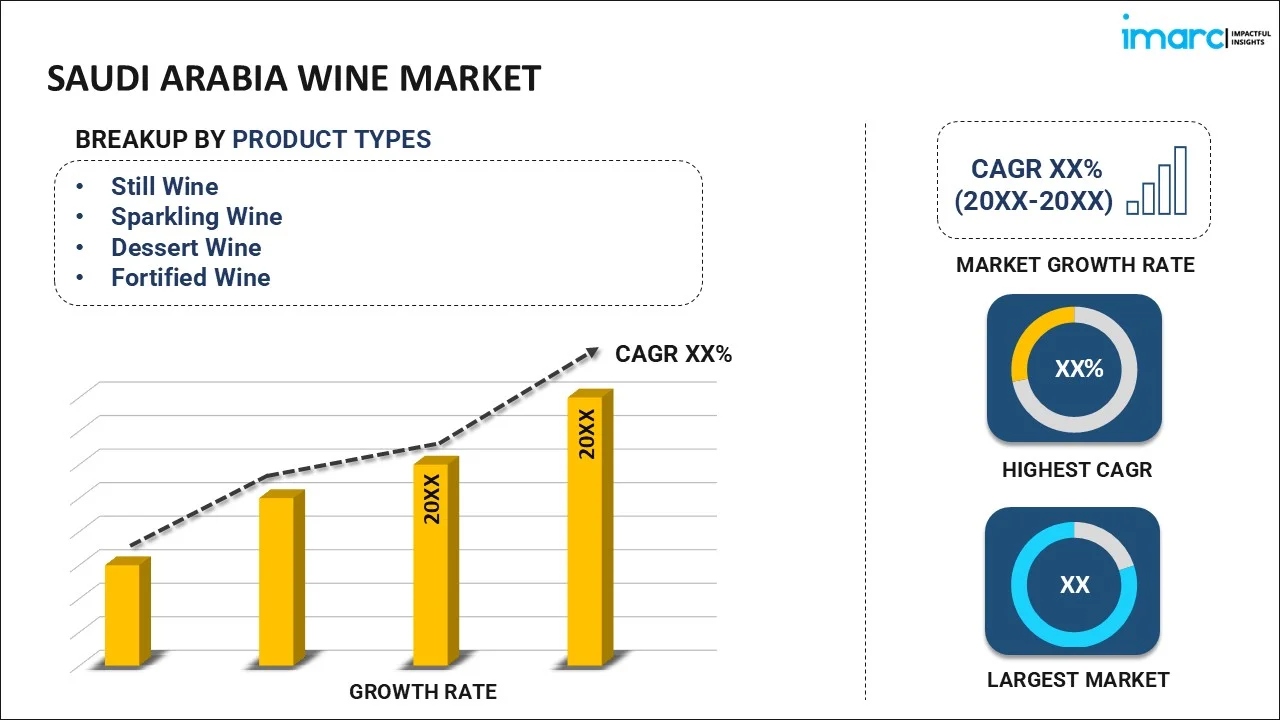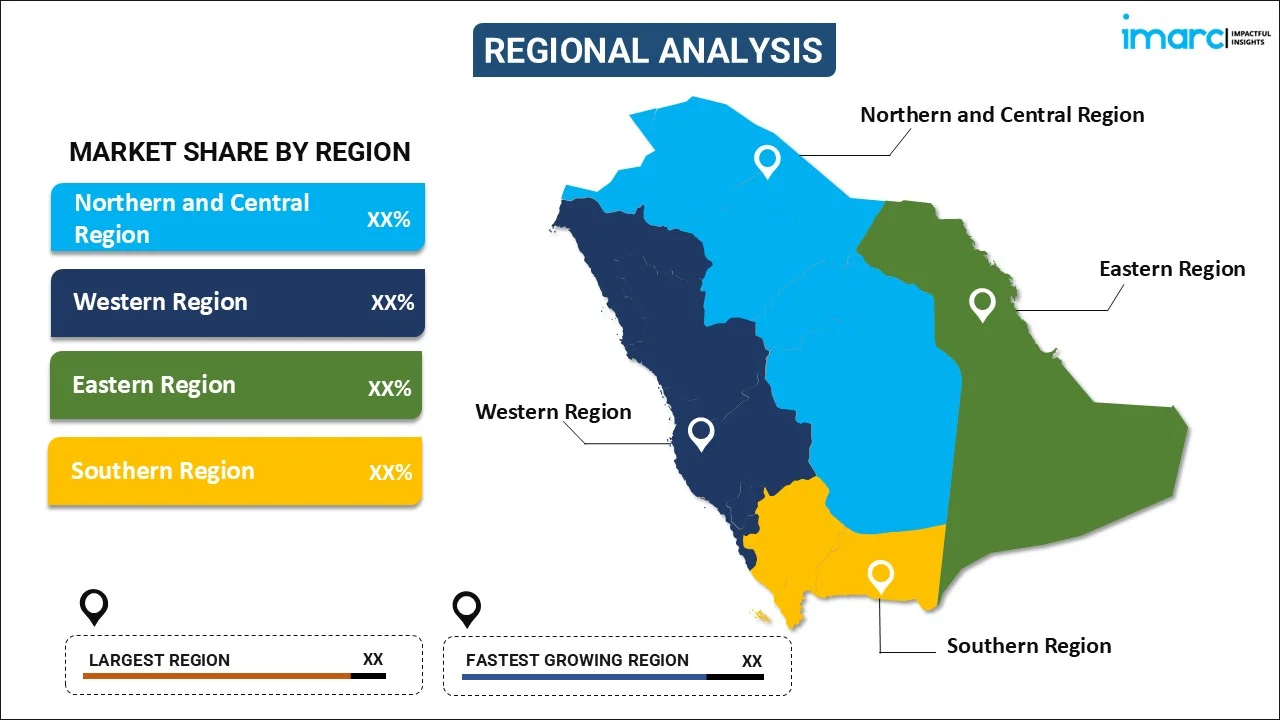
Saudi Arabia Wine Market Report by Product Type (Still Wine, Sparkling Wine, Dessert Wine, Fortified Wine), Color (Red Wine, Rose Wine, White Wine), Distribution Channel (Offline, Online), and Region 2025-2033
Saudi Arabia Wine Market Overview:
The Saudi Arabia wine market size reached USD 4.7 Billion in 2024. Looking forward, IMARC Group expects the market to reach USD 7.7 Billion by 2033, exhibiting a growth rate (CAGR) of 5.60% during 2025-2033. The increasing consumer interest in non-alcoholic wine alternatives, expanding expatriate population, upscale dining experiences, shifting cultural norms, thriving tourism sector, inflating disposable income, and government initiatives promoting food and beverage (F&B) innovation are a few factors propelling the market growth.
|
Report Attribute
|
Key Statistics
|
|---|---|
|
Base Year
|
2024
|
|
Forecast Years
|
2025-2033
|
|
Historical Years
|
2019-2024
|
| Market Size in 2024 | USD 4.7 Billion |
| Market Forecast in 2033 | USD 7.7 Billion |
| Market Growth Rate 2025-2033 | 5.60% |
Saudi Arabia Wine Market Trends:
Rising Demand for Non-Alcoholic Wine Alternatives:
With the rising acceptance and demand for non-alcoholic wine, the wine market in Saudi Arabia is experiencing significant growth. The implementation of strict government regulations that prohibit alcoholic beverages and has seen a surge in interest in alcohol-free alternatives. As a result, with an increasing number of people looking for non-alcoholic wines to enjoy the experience without going against their cultural or religious beliefs, the market is experiencing robust growth. The market is also supported by the expanding prevalence of health-conscious consumers who seek beverages that align with a balanced lifestyle. Additionally, ongoing product innovation is propelling the market forward, as brands focus on expanding their portfolios to include a wide range of non-alcoholic wine options, ranging from sparkling and red wines to whites and roses, providing consumers with choices that cater to varied tastes.
Growth in Premium Dining and Luxury Hospitality:
Extensive investments in upscale dining experiences, as Saudi Arabia aims to position itself as a global tourism hub, are contributing to the market expansion. As part of the 2030 Vision, high-end restaurants, luxury hotels, and boutique resorts are incorporating non-alcoholic wines into their offerings. This move aims to attract a sophisticated clientele that values exclusivity and high-quality dining, aligning with the goal to diversify the economy and promote tourism. Additionally, the integration of non-alcoholic wines into high-end dining caters tourists to the growing middle and upper-class segments of the local population who are exploring refined dining options. As a result, the availability of these beverages at prestigious dining venues boosts their visibility, thus aiding in market expansion.
Focus on Local Production and Expanded Distribution Networks:
The increasing emphasis on local production and distribution networks is acting as another growth-inducing factor. With an exponential surge in imports, there is a noticeable rise in the production of non-alcoholic beverages, like wines, within the country. This strategic shift supports the local economy, reducing dependence on imports and aligning with sustainable practices. Moreover, local production helps in customizing products to fit the unique preferences of Saudi consumers, from flavor profiles to packaging, appealing to regional tastes. Additionally, the expansion of distribution channels, including e-commerce platforms, specialty grocery stores, and luxury retail outlets, has made non-alcoholic wines more accessible to a wider audience. Apart from this, the digital shift has driven changes in consumer behavior, facilitating convenient online purchases and making it easier for consumers to explore and buy premium non-alcoholic wines from the comfort of their homes, thereby fueling the market demand.
Saudi Arabia Wine Market News:
- In January 2024, Saudi Arabia opened a new wine shop in Riyadh, exclusively for a consortium of international diplomats and luxury retailers, after a 70-year hiatus. It caters to the diplomatic community, offering exclusive wine selections, fine-tasting experiences, and personalized services, promoting cultural exchange and luxury living.
Saudi Arabia Wine Market Segmentation:
IMARC Group provides an analysis of the key trends in each segment of the market, along with forecasts at the country level for 2025-2033. Our report has categorized the market based on product type, colors, and distribution channel.
Product Type Insights:

- Still Wine
- Sparkling Wine
- Dessert Wine
- Fortified Wine
The report has provided a detailed breakup and analysis of the market based on the product type. This includes still wine, sparkling wine, dessert wine and fortified wine.
Colors Insights:
- Red Wine
- Rose Wine
- White Wine
A detailed breakup and analysis of the market based on the colors have also been provided in the report. This includes red wine, rose wine, and white wine.
Distribution Channel Insights:
- Offline
- Online
The report has provided a detailed breakup and analysis of the market based on the distribution channel. This includes offline and online.
Regional Insights:

- Northern and Central Region
- Western Region
- Eastern Region
- Southern Region
The report has also provided a comprehensive analysis of all the major regional markets, which include Northern and Central Region, Western Region, Eastern Region, and Southern Region.
Competitive Landscape:
The market research report has also provided a comprehensive analysis of the competitive landscape. Competitive analysis such as market structure, key player positioning, top winning strategies, competitive dashboard, and company evaluation quadrant has been covered in the report. Also, detailed profiles of all major companies have been provided.
Saudi Arabia Wine Market Report Coverage:
| Report Features | Details |
|---|---|
| Base Year of the Analysis | 2024 |
| Historical Period | 2019-2024 |
| Forecast Period | 2025-2033 |
| Units | USD Billion |
| Scope of the Report | Exploration of Historical Trends and Market Outlook, Industry Catalysts and Challenges, Segment-Wise Historical and Future Market Assessment:
|
| Product Types Covered | Still Wine, Sparkling Wine, Dessert Wine, Fortified Wine |
| Colors Covered | Red Wine, Rose Wine, White Wine |
| Distribution Channels Covered | Offline, Online |
| Regions Covered | Northern and Central Region, Western Region, Eastern Region, Southern Region |
| Customization Scope | 10% Free Customization |
| Post-Sale Analyst Support | 10-12 Weeks |
| Delivery Format | PDF and Excel through Email (We can also provide the editable version of the report in PPT/Word format on special request) |
Key Questions Answered in This Report:
- How has the Saudi Arabia wine market performed so far and how will it perform in the coming years?
- What has been the impact of COVID-19 on the Saudi Arabia wine market?
- What is the breakup of the Saudi Arabia wine market on the basis of product type?
- What is the breakup of the Saudi Arabia wine market on the basis of colors?
- What is the breakup of the Saudi Arabia wine market on the basis of distribution channel?
- What are the various stages in the value chain of the Saudi Arabia wine market?
- What are the key driving factors and challenges in the Saudi Arabia wine?
- What is the structure of the Saudi Arabia wine market and who are the key players?
- What is the degree of competition in the Saudi Arabia wine market?
Key Benefits for Stakeholders:
- IMARC’s industry report offers a comprehensive quantitative analysis of various market segments, historical and current market trends, market forecasts, and dynamics of the Saudi Arabia wine market from 2019-2033.
- The research report provides the latest information on the market drivers, challenges, and opportunities in the Saudi Arabia wine market.
- Porter's five forces analysis assist stakeholders in assessing the impact of new entrants, competitive rivalry, supplier power, buyer power, and the threat of substitution. It helps stakeholders to analyze the level of competition within the Saudi Arabia wine industry and its attractiveness.
- Competitive landscape allows stakeholders to understand their competitive environment and provides an insight into the current positions of key players in the market.
Need more help?
- Speak to our experienced analysts for insights on the current market scenarios.
- Include additional segments and countries to customize the report as per your requirement.
- Gain an unparalleled competitive advantage in your domain by understanding how to utilize the report and positively impacting your operations and revenue.
- For further assistance, please connect with our analysts.
 Inquire Before Buying
Inquire Before Buying
 Speak to an Analyst
Speak to an Analyst
 Request Brochure
Request Brochure
 Request Customization
Request Customization




.webp)




.webp)












